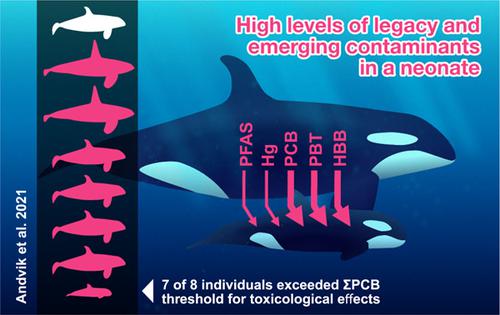当前位置:
X-MOL 学术
›
Environ. Toxicol. Chem.
›
论文详情
Our official English website, www.x-mol.net, welcomes your feedback! (Note: you will need to create a separate account there.)
High Levels of Legacy and Emerging Contaminants in Killer Whales (Orcinus orca) from Norway, 2015 to 2017
Environmental Toxicology and Chemistry ( IF 4.1 ) Pub Date : 2021-05-18 , DOI: 10.1002/etc.5064 Clare Andvik 1 , Eve Jourdain 2 , Jan L Lyche 3 , Richard Karoliussen 2 , Katrine Borgå 1
Environmental Toxicology and Chemistry ( IF 4.1 ) Pub Date : 2021-05-18 , DOI: 10.1002/etc.5064 Clare Andvik 1 , Eve Jourdain 2 , Jan L Lyche 3 , Richard Karoliussen 2 , Katrine Borgå 1
Affiliation

|
Little is known of the movement or presence of unregulated, emerging contaminants in top predators. The aim of the present study was to conduct the first screening of legacy and emerging contaminants in multiple tissues of killer whales (Orcinus orca) from Norway and investigate tissue partitioning and maternal transfer. Blubber was collected from 8 killer whales in 2015 to 2017, in addition to muscle from 5 of the individuals, and kidney, liver, heart, and spleen from a neonate. We screened for 4 unregulated brominated flame retardants and found pentabromotoluene (PBT) and hexabromobenzene (HBB) at low levels in the blubber of all individuals (median PBT 0.091 ng/g lipid wt, median HBB 1.4 ng/g lipid wt). Levels of PBT and HBB (wet wt) were twice as high in the blubber than the muscle for each individual, confirming preferential accumulation in lipid-rich tissues. Perfluoroalkyl substances and total mercury levels were lower in the neonate than adults, suggesting less efficient maternal transfer of these substances. Polychlorinated biphenyl levels in blubber exceeded the threshold for onset of physiological effects (9 µg/g lipid wt) in 7 of the 8 whales, including the neonate. The presence of PBT and HBB in the neonate is the first evidence of maternal transfer of these unregulated contaminants in marine mammals. Our results are relevant for the continued environmental monitoring of contaminants in the Arctic. Environ Toxicol Chem 2021;40:1850–1860. © 2021 The Authors. Environmental Toxicology and Chemistry published by Wiley Periodicals LLC on behalf of SETAC.
中文翻译:

2015 年至 2017 年挪威虎鲸 (Orcinus orca) 的高水平遗留和新兴污染物
对于顶级捕食者中不受管制的新兴污染物的运动或存在知之甚少。本研究的目的是对虎鲸 ( Orcinus orca ) 多个组织中遗留和新出现的污染物进行首次筛查) 来自挪威并研究组织分割和母体转移。在 2015 年至 2017 年期间,从 8 头虎鲸身上采集了鲸脂,此外还有 5 头虎鲸的肌肉,以及一名新生儿的肾脏、肝脏、心脏和脾脏。我们筛选了 4 种不受管制的溴化阻燃剂,发现所有个体的鲸脂中五溴甲苯 (PBT) 和六溴苯 (HBB) 含量较低(PBT 中位数为 0.091 ng/g 脂质重量,HBB 中位数为 1.4 ng/g 脂质重量)。对于每个人来说,鲸脂中的 PBT 和 HBB(湿 wt)水平是肌肉中的两倍,这证实了在富含脂质的组织中的优先积累。新生儿的全氟烷基物质和总汞水平低于成人,表明这些物质的母体转移效率较低。鲸脂中的多氯联苯水平超过了 8 头鲸鱼(包括新生儿)中的 7 头的生理效应阈值(9 µg/g 脂质重量)。新生儿中 PBT 和 HBB 的存在是这些不受管制的污染物在海洋哺乳动物中母体转移的第一个证据。我们的结果与北极污染物的持续环境监测有关。环境毒物化学2021;40:1850–1860。© 2021 作者。Wiley Periodicals LLC 代表 SETAC 出版的Environmental Toxicology and Chemistry 。
更新日期:2021-06-25
中文翻译:

2015 年至 2017 年挪威虎鲸 (Orcinus orca) 的高水平遗留和新兴污染物
对于顶级捕食者中不受管制的新兴污染物的运动或存在知之甚少。本研究的目的是对虎鲸 ( Orcinus orca ) 多个组织中遗留和新出现的污染物进行首次筛查) 来自挪威并研究组织分割和母体转移。在 2015 年至 2017 年期间,从 8 头虎鲸身上采集了鲸脂,此外还有 5 头虎鲸的肌肉,以及一名新生儿的肾脏、肝脏、心脏和脾脏。我们筛选了 4 种不受管制的溴化阻燃剂,发现所有个体的鲸脂中五溴甲苯 (PBT) 和六溴苯 (HBB) 含量较低(PBT 中位数为 0.091 ng/g 脂质重量,HBB 中位数为 1.4 ng/g 脂质重量)。对于每个人来说,鲸脂中的 PBT 和 HBB(湿 wt)水平是肌肉中的两倍,这证实了在富含脂质的组织中的优先积累。新生儿的全氟烷基物质和总汞水平低于成人,表明这些物质的母体转移效率较低。鲸脂中的多氯联苯水平超过了 8 头鲸鱼(包括新生儿)中的 7 头的生理效应阈值(9 µg/g 脂质重量)。新生儿中 PBT 和 HBB 的存在是这些不受管制的污染物在海洋哺乳动物中母体转移的第一个证据。我们的结果与北极污染物的持续环境监测有关。环境毒物化学2021;40:1850–1860。© 2021 作者。Wiley Periodicals LLC 代表 SETAC 出版的Environmental Toxicology and Chemistry 。



























 京公网安备 11010802027423号
京公网安备 11010802027423号